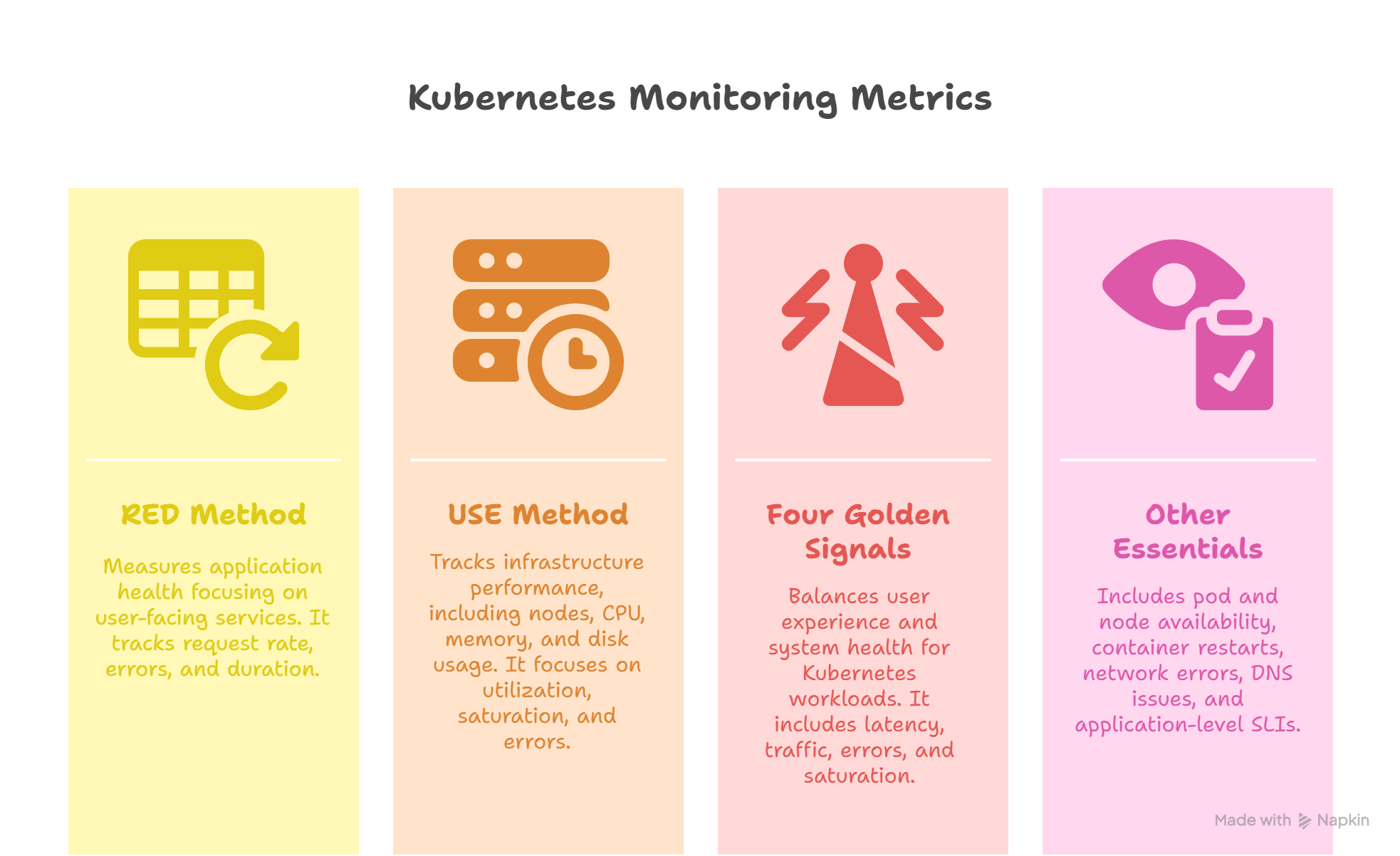Top Kubernetes Monitoring Tools in 2025, And Why Alerting Is Critical for DevOps and SRE Teams

What are the best Kubernetes monitoring tools in 2025? And how can you ensure alerts actually drive action when something goes wrong? Kubernetes monitoring is critical for keeping your containerized applications healthy, but alerting is often overlooked. This blog compares popular tools like Prometheus and Datadog and explains why intelligent alerting solutions like OnPage are essential for effective incident response.
Kubernetes has become the industry-leading platform for orchestrating containerized applications at scale across cloud-native environments. While Kubernetes offers great flexibility, it also introduces complexity that makes real-time monitoring and observability essential. Tracking cluster health, resource utilization, and performance metrics helps DevOps and SRE teams keep workloads stable and highly available. However, many Kubernetes monitoring strategies overlook the most critical piece of the puzzle: intelligent alerting and incident management.
While platforms like Prometheus, Grafana, and Datadog are powerful tools for tracking metrics and visualizing data, they often stop short at notification. They tell you something’s wrong, but don’t necessarily ensure that someone acts on it. In this blog, we’ll compare the most popular Kubernetes monitoring tools, explain what you should be monitoring, and show you why intelligent alerting platforms like OnPage are essential for closing the loop.
What Are the Best Kubernetes Monitoring Tools in 2025?
- Prometheus + Alertmanager Prometheus is an open-source time-series database built for reliability and scalability in dynamic environments like Kubernetes. With its powerful query language (PromQL), it’s often the go-to choice for collecting cluster metrics.
-
- Strengths: Native Kubernetes integration, customizable alerts, large community.
- Limitations: Alertmanager requires manual configuration for routing/escalation; lacks mobile-first alerting and accountability tracking.
- Grafana Grafana is the visualization layer often paired with Prometheus. It helps teams create intuitive dashboards and understand real-time metrics.
-
- Strengths: Beautiful dashboards, plugin ecosystem, alerting on threshold breaches.
- Limitations: Limited incident response capabilities; doesn’t handle escalations or on-call scheduling.
- Datadog Datadog provides a comprehensive cloud-native monitoring platform combining logs, traces, metrics and security.
-
- Strengths: Seamless integrations, AI-based anomaly detection, rich UI.
- Limitations: Alert fatigue risk; lacks built-in escalation flows and intelligent routing.
- New Relic New Relic provides end-to-end application performance monitoring with auto-instrumentation features.
-
- Strengths: APM-level insights, distributed tracing, Kubernetes monitoring add-ons.
- Limitations: Similar to others, lacks context-aware alerting and robust mobile support.
While each tool excels in observability, they often depend on external systems to manage alerting, response, and accountability.
| Tool | Strengths | Limitations | Alerting Coverage | Best for Teams That… |
|---|---|---|---|---|
| Prometheus + Alertmanager | – Native K8s integration – Customizable with PromQL – Large OSS community |
– Manual routing config – No mobile-first alerts |
Basic alerts via Alertmanager | Prefer open-source, hands-on customization, and CLI work |
| Grafana | – Intuitive dashboards – Strong plugin ecosystem – Supports threshold alerts |
– No built-in escalation – Weak incident response layer |
Limited built-in alerting | Focus on visualization and already using Prometheus stack |
| Datadog | – Full-stack observability – AI anomaly detection – Sleek UI |
– Alert fatigue risk – Lacks deep routing/escalation |
Basic routing, lacks depth | Want a polished UI with quick integrations and coverage |
| New Relic | – APM-level insights – K8s monitoring add-ons – Distributed tracing |
– Weak mobile support – Not context-aware |
Surface-level alerting | Need code-level tracing with basic alerting built-in |
What Metrics Should You Monitor in Kubernetes?
Effective Kubernetes monitoring and observability isn’t about capturing every possible metric, it’s about tracking the most important signals of cluster health and application performance. This ensures your incident response workflows focus on the right alerts and avoid noise. Let’s look at three proven frameworks widely used by SREs and DevOps teams:

The RED Method (for Microservices)
- Rate: Number of requests per second
- Errors: Rate of failed requests
- Duration: Time it takes to process a request
This method focuses on user-facing services and is ideal for measuring application health.
The USE Method (for Infrastructure)
- Utilization: How much of a resource is used
- Saturation: How much demand exceeds capacity
- Errors: Count of resource errors (e.g., disk errors)
USE is helpful for tracking performance of nodes, CPU, memory, and disk usage.
The Four Golden Signals (Google SRE)
- Latency
- Traffic
- Errors
- Saturation
This hybrid framework is great for Kubernetes workloads as it balances user experience and system health.
Other essentials to monitor include:
- Pod and node availability
- Container restart counts
- Network errors and latency
- DNS resolution issues
- Application-level SLIs (e.g., HTTP error rates, request time)
Why Kubernetes Alerting is Critical to Incident Response
While Kubernetes monitoring and observability platforms surface critical data about your cluster’s state, they often fall short in automated incident management. Without intelligent alerting that incorporates on-call scheduling, escalation policies, and accountability tracking, teams risk missed incidents and increased mean time to resolution (MTTR).
This is where alerting comes in. And not just any alerting — we’re talking about intelligent alerting:
- Escalates automatically if the first responder doesn’t acknowledge.
- Routes based on on-call schedules and team availability.
- Sends alerts as high-priority push notifications that cut through digital noise.
- Tracks when an alert was read and acted on.
Without this, teams risk alert fatigue, missed incidents, or slow MTTR (Mean Time to Resolution).
How OnPage Improves Kubernetes Alerting and Response
OnPage is an advanced intelligent alerting platform designed to complement Kubernetes observability stacks by transforming passive alerts into actionable, real-time notifications. Seamlessly integrating with tools like Prometheus and Datadog, OnPage enhances incident response automation, on-call management, and alert escalation workflows — helping DevOps and SRE teams reduce downtime and improve reliability.
OnPage is the alerting solution that complements your Kubernetes monitoring stack. It integrates with Prometheus, Datadog, and other tools to transform critical alerts into persistent, high-priority mobile notifications with:
- Escalation policies based on urgency
- On-call scheduling and automated routing
- Acknowledgement tracking and audit trails
- Voice, SMS, email, and push options for redundancy
With OnPage, your monitoring stack doesn’t end with a dashboard or a basic email alert — it results in actionable, accountable response workflows that reduce downtime and improve reliability.
TL;DR: Close the Loop from Monitoring to Resolution
Kubernetes monitoring tells you what’s broken, but intelligent alerting ensures someone fixes it. Tools like Prometheus, Grafana, and Datadog surface issues, but without automated alerting, escalation, and on-call routing, incidents can slip through the cracks. OnPage’s incident alert management closes the loop by turning observability into action, reducing downtime and improving reliability in cloud-native environments.






